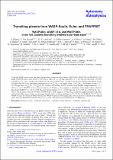Transiting planets from WASP-South, Euler, and TRAPPIST : WASP-68 b, WASP-73 b, and WASP-88 b, three hot Jupiters transiting evolved solar-type stars
Abstract
Using the WASP transit survey, we report the discovery of three new hot Jupiters, WASP-68 b, WASP-73 b and WASP-88 b. The planet WASP-68 b has a mass of 0.95 ± 0.03 MJup, a radius of 1.24-0.06+0.10 RJup, and orbits a V = 10.7 G0-type star (1.24 ± 0.03 M⊙ 1.69-0.06+0.11 R⊙, Teff = 5911 ± 60 K) with a period of 5.084298 ± 0.000015 days. Its size is typical of hot Jupiters with similar masses. The planet WASP-73 bis significantly more massive (1.88-0.06+0.07 MJup) and slightly larger (1.16-0.08+0.12 RJup) than Jupiter. It orbits a V = 10.5 F9-type star (1.34-0.04+0.05 M⊙, 2.07-0.08+0.19 R⊙, Teff = 6036 ± 120 K) every 4.08722 ± 0.00022 days. Despite its high irradiation (~2.3 × 109 erg s-1 cm-2), WASP-73 b has a high mean density (1.20-0.30+0.26 ρJup) that suggests an enrichment of the planet in heavy elements. The planet WASP-88 bis a 0.56 ± 0.08 MJuphot Jupiter orbiting a V = 11.4 F6-type star (1.45 ± 0.05 M⊙, 2.08-0.06+0.12 R⊙, Teff = 6431 ± 130 K) with a period of 4.954000 ± 0.000019 days. With a radius of 1.70-0.07+0.13 RJup, it joins the handful of planets with super-inflated radii. The ranges of ages we determine through stellar evolution modeling are 4.5–7.0 Gyr for WASP-68, 2.8-5.7 Gyr for WASP-73 and 1.8–4.3 Gyr for WASP-88. The star WASP-73 appears to be significantly evolved, close to or already in the subgiant phase. The stars WASP-68 and WASP-88 are less evolved, although in an advanced stage of core H-burning.
Citation
Delrez , L , Van Grootel , V , Anderson , D R , Collier-Cameron , A , Doyle , A P , Fumel , A , Gillon , M , Hellier , C , Jehin , E , Lendl , M , Neveu-VanMalle , M , Maxted , P F L , Pepe , F , Pollacco , D , Queloz , D , Ségransan , D , Smalley , B , Smith , A M S , Southworth , J , Triaud , A H M J , Udry , S & West , R G 2014 , ' Transiting planets from WASP-South, Euler, and TRAPPIST : WASP-68 b, WASP-73 b, and WASP-88 b, three hot Jupiters transiting evolved solar-type stars ' , Astronomy & Astrophysics , vol. 563 , A143 . https://doi.org/10.1051/0004-6361/201323204
Publication
Astronomy & Astrophysics
Status
Peer reviewed
ISSN
0004-6361Type
Journal article
Description
Funding for WASP comes from consortium universities and from UK’s Science and Technology Facilities Council. TRAPPIST is a project funded by the Belgian Fund for Scientific Research (Fonds National de la Recherche Scientifique, F.R.S.-FNRS) under grant FRFC 2.5.594.09.F, with the participation of the Swiss National Science Fundation (SNF). L. Delrez acknowledges the support of the F.R.I.A. fund of the FNRS. M. Gillon and E. Jehin are FNRS Research Associates. A. H. M. J. Triaud received funding from a fellowship provided by the Swiss National Science Foundation under grant number PBGEP2-14559.Collections
Items in the St Andrews Research Repository are protected by copyright, with all rights reserved, unless otherwise indicated.

